Heavy marketed protein powder ..some facts
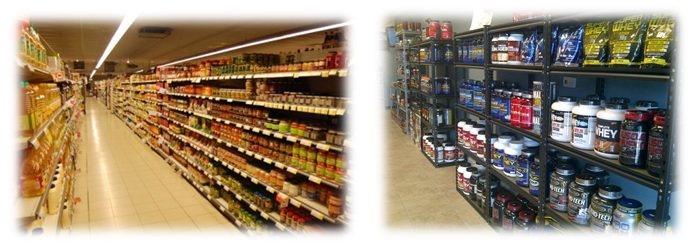
If we would take a native from a primitive country and would take him to a supermarket and tell him that everything he saw in the shelves was food. That that box filled with powder was soup. He would not understand. And neither should we, because we have grown to believe that the chemical dead powder in that colorful box IS soup, just add some water and you end up ?? With what??
Everyone that follows my blogposts at JuicedMuscle and previously at BodyOfScience and BodyPage knows that I believe in genuine nutrition and products. I wrote about highly processed foods here: //www.juicedmuscle.com/jmblog/content/processed-food
Now I would like to take a closer look at the sweetheart of bodybuilders, fitnessers and dieters, called PROTEIN POWDERS.
A little History
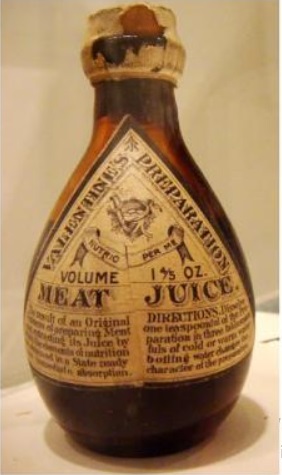 First let’s start with the beginning to get you to understand. Already in the beginning of the 1900 bodybuilders like Sandow realized that they were almost unable to eat the big quantities of lean meat and other sources of protein, they felt where needed for muscle building and muscle recovering. Thus they started to extract the basics from the meat and called it “beef juice” or “meat juice” (see pic).
First let’s start with the beginning to get you to understand. Already in the beginning of the 1900 bodybuilders like Sandow realized that they were almost unable to eat the big quantities of lean meat and other sources of protein, they felt where needed for muscle building and muscle recovering. Thus they started to extract the basics from the meat and called it “beef juice” or “meat juice” (see pic).
Then in the 1950’s, Irvin Johnson, also known as Rheo H. Blair made some of the first powders designed specifically for athletes. His product was high quality protein from milk and eggs. Bob Hoffman and Joe Weider decided to jump on the bandwagon and created their own protein powders but these were made from cheaper ingredients such as soy beans, wheat germ, kelp, dextrose and various types of dehydrated plants. As always some bad people try to get rich at the expense of other people. Where the first pioneers tried to help themselves and fellow athletes, soon others saw this fruitful market and started to sell crap. Only a handful of specialist shops sold the powder and new customers were often found by targeting their personal trainers.
In the early days they were very much associated with body building. Until the late 90s very few people outside that high performance athletic and bodybuilding community had heard of them.
An "extreme" group of athletes working out in gyms were the pioneers for the supplements' High protein products such as powders, bars, tablets, gels and drinks - usually aimed at building muscle growth or speeding recovery .
Protein supplements do have a place used once a day after muscle-building training, but most people - including regular gym goers - would find that milk contains the right combination of protein and carbohydrates for rehydration and repair, according to the British Dietetic Association.
The key is a balanced diet, but supplements can be attractive and useful, but moderation is the keyword.
The good the bad and the ugly
These companies spend more money on packaging and promoting their products than formulating them with the best ingredients that they can.
Many protein powders are highly processed and are often heated to the point that often leaves a highly denatured, which makes it nearly impossible for the body to recognize and use. This includes the “low temperature” protein powders at the health food store. Though less damaging, low heat denatures the proteins as well. The result is higher levels of acidity and toxicity in the body, which can lead to plenty of unwanted illnesses and diseases.
Processed protein powders may also contain large amounts of MSG in the form of protein isolates because separating protein from its food source during manufacturing results in the creation of MSG. You won’t see it in the list of ingredients because it is a by-product of manufacturing and does not have to be listed.
Protein powders are often filled with preservatives, genetically modified organisms (GMOs), allergens like dairy (whey protein isolate) and soy, and other synthetic toxins like aspartame, saccharin, and artificial colors are all things you might see on the label.
Aspartame and saccharin are also present in diet drinks, and many people combine all kinds of “light products”. A drink or a shake now and then is probably fine but a few diet drinks and shakes per day. Cut down on the crap, and just enjoy the sugar! Or better drink and eat natural products, you can use products with no artificial sweeteners or sugars.

Regulation that includes premarket testing of safety can ensure that accurate and informative product information is available. Currently, consumers and physicians remain uninformed because premarket testing of supplement safety is not required. This asymmetry of information between sellers and consumers leads to domination of the market by low-quality products because the regulatory framework creates financial disincentives to sell high-quality supplements.”
Heavy metals
 There were rumors on the diverse fora, that the powders (active pharmaceutical ingredients) used by Underground Labs, to manufacture their anabolic steroids contained dangerous amounts of heavy metals and other toxic compounds. Maybe the bodybuilders should have had more concern for their protein drinks and supplements as you’ll find out later in this blogpost. This made us decide to test a lot of different samples of injectables from UG Labs. We published the results in our book “Underground Anabolics.”
There were rumors on the diverse fora, that the powders (active pharmaceutical ingredients) used by Underground Labs, to manufacture their anabolic steroids contained dangerous amounts of heavy metals and other toxic compounds. Maybe the bodybuilders should have had more concern for their protein drinks and supplements as you’ll find out later in this blogpost. This made us decide to test a lot of different samples of injectables from UG Labs. We published the results in our book “Underground Anabolics.”
Because protein powders are not regulated by the FDA, a concerned mother who had a son that used a lot of protein drinks, sent a sample to an independent lab. She warned Consumer Reports and in July 2010 they conducted an eye-opening study, showing that several protein powders on the market contain dangerous levels of toxic heavy metals — specifically arsenic, cadmium and lead. In a study of 15 protein drinks, the researchers found:“All drinks in our tests had at least one sample containing one or more of the following contaminants: arsenic, cadmium, lead, and mercury.”
Even though the levels were relatively low, imagine consuming these products every day, sometimes 2-3 times a day as recommended by some health coaches. Alarmingly, the amount of lead in a single serving in 8 of the tested protein supplements would require a warning label in the state of California.
In today's world, it is so easy to just grab a box, package or drink off shelf and slam it down without really taking time to think about what we are putting into our body each day. Protein powders, just like energy bars, are just one of those things that many people go to out of convenience. Any pre-packaged food needs a double look at the ingredients, and to note how your body reactions to it. Some are really good, especially in a pinch on a busy day. But some people actually "rely" on protein powders and other pre-packed “health supplements”. They get used to this “quick fix”. They believe all the promises in the ads. These “healthy” protein products will help you to achieve that hot desired hard body and the energy needed to do all daily things including a hard work-out.
The long of the short here is that there are way too many risks, which far supersede the promised health claims of protein powders. The good news is you don’t have to rely on these supplements, because you can get all the protein you need from eating real whole foods!
Actually the minimum is 0.8g/kg of body weight to maintain a positive nitrogen balance unless you are at all active... body builders/weight lifters need more, endurance athletes need up to 1.16g/kg per day to maintain a positive nitrogen balance. Most people get too much protein
Blending
Most companies that sell protein supplements buy their product from manufacturers or “blenders”. They can blend all kinds of protein powders and add other ingredients as the client wishes. Both of them buy their products in large quantities (bulk) and most of them are unable to perform testing/analyses. Others deliberately use cheaper ingredients. “Partly because the global supply chain of raw ingredients for nutritional supplements has become increasingly complex, the opportunities for product adulteration has also risen” (Shao, 2010).
Again I point my finger to you the end-user. The companies produce what the market wants, they influence the market with commercials and advertisements, but still. Most end-users want powders, meal-replacement powders or “ready-to-drink” products that can be stored at room temperature, tastes good, looks, good, smells good and dissolves very easy, cause they want to use a blender anymore to make a foamy shake. And above all they want it cheap, if product B is cheaper than product A they go for that. What they don’t understand is that they mostly buy a bunch of sweet crap.
 In the 1980's bodybuilding supplements started becoming very big business and the greed really started to show, so many useless products were sold to unsuspecting bodybuilders, often young people, who believed the false claims made in the ads.
In the 1980's bodybuilding supplements started becoming very big business and the greed really started to show, so many useless products were sold to unsuspecting bodybuilders, often young people, who believed the false claims made in the ads.
Let me emphasize that people who believe all these nonsense mostly don’t take the time to educate themselves. They see all these false promises in advertisements. It started with oversized jars accompanied by bodybuilders juiced up with steroids stating they only use this brand (their sponsor). People want a lot and they want it cheap. It’s often that group of people buying crap. It’s the same group of people that also buys the underground under-dosed or mislabeled crap steroids, why? They want quality but don’t want to pay for quality, thus they end up buying useless crap. Either juice or “supplement” or protein powders. Again: if it looks too good to be true….
The promises are enticing. Whether you're looking to shed unwanted pounds, get a quick energy jolt, build muscles, or fight the aging process, protein drinks are being boosted by some supplement makers as a scientifically proven way to quickly achieve your goals.
The products, sold as ready-to-drink liquids or powders that you mix with milk, juice, or water to make shakes, attract not just athletes and body-builders but also baby boomers, pregnant women, and teenagers looking for a shortcut to a buff body.
Some ads say that protein supplements, in flavors such as strawberry and vanilla cream, can be a nutritious and time-saving snack or meal replacement.
Marketing for Energy First Pro Energy Whey Protein Isolate says the protein supplement is "ideal" for pregnant women and growing children, and also offers this promise for aging adults who use it: "You  will rarely if ever be sick and you will begin to look and feel years younger."
will rarely if ever be sick and you will begin to look and feel years younger."
In a testimonial for BSN Lean Dessert Protein Shake, "fitness celebrity" Jennifer Nicole Lee says, "Being a busy mom with 12-hour workdays, I rely upon my Lean Dessert Protein to get adequate amounts of protein without wasting time on creating complex meals ...."
Another product, Muscle Milk, boasts on its website: "Designed after one of nature's most balanced foods: human mother's milk ...."
Teenagers who want to look like the sculpted images they see in fitness magazines are particularly vulnerable to the marketing messages, experts say, because they are easily hooked by the promise of "hope in a can." They tend to overuse the products, assuming that if one scoop is good, four or five would be even better. A 2005 study published in Pediatrics, the journal of the American Academy of Pediatrics, found that protein powders and shakes were the supplements most commonly used by those aged 12 to 18.
How is it possible that bad manufacturers and supplement companies can get away with selling useless or even dangerous products. Protein powders are considered a supplement, and supplements are not even regulated by the FDA.
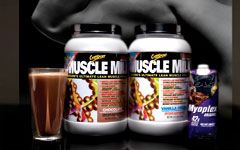 n July 2010 Consumer Reports conducted an eye-opening study, showing that several protein powders on the market contain dangerous levels of toxic heavy metals — specifically arsenic, cadmium and lead. In a study of 15 protein drinks, the researchers found: “All drinks in our tests had at least one sample containing one or more of the following contaminants: arsenic, cadmium, lead, and mercury.”
n July 2010 Consumer Reports conducted an eye-opening study, showing that several protein powders on the market contain dangerous levels of toxic heavy metals — specifically arsenic, cadmium and lead. In a study of 15 protein drinks, the researchers found: “All drinks in our tests had at least one sample containing one or more of the following contaminants: arsenic, cadmium, lead, and mercury.”
We purchased 15 protein powders and drinks mainly in the New York metro area or online and tested multiple samples of each for arsenic, cadmium, lead, and mercury. The results showed a considerable range, but levels in three products were of particular concern because consuming three servings a day could result in daily exposure to arsenic, cadmium, or lead exceeding the limits proposed by USP.
We found that three daily servings of the ready-to-drink liquid EAS Myoplex Original Rich Dark Chocolate Shake provides an average of 16.9 micrograms (µg) of arsenic, exceeding the proposed USP limit of 15 µg per day, and an average of 5.1 µg of cadmium, which is just above the USP limit of 5 µg per day. Concentrations in most products were relatively low, but when taking into account the large serving size suggested, the number of micrograms per day for a few of the products was high compared with most others tested.
The samples of Muscle Milk Chocolate powder we tested contained all four heavy metals, and levels of three metals in the product were among the highest of all in our tests. Average cadmium levels of 5.6 µg in three daily servings slightly exceeded the USP limit of 5 µg per day, and the average lead level of 13.5 µg also topped the USP limit of 10 µg per day. The average arsenic level of 12.2 µg was approaching the USP limit of 15 µg per day, and the average for mercury was 0.7 µg, well below the USP's 15 µg-per-day limit. Three daily servings of Muscle Milk Vanilla Crème contained 12.2 µg of lead, exceeding lead limits, and 11.2 µg of arsenic. A fourth product, Muscle Milk Nutritional Shake Chocolate (liquid), provided an average of 14.3 µg of arsenic per day from three servings, approaching the proposed USP limit.
Cadmium raises special concern because it accumulates in and can damage the kidneys, the same organs that can be damaged by excessive protein consumption. And it can take 20 years for the body to eliminate even half the cadmium absorbed today.
This is a highly toxic metal, and while there are some cases where decisions have to be weighed against relative risks, accepting that you have to be exposed to any cadmium at all in your protein drink after your workout is definitely not one of them.
When these toxic heavy metals are combined in a product that is marketed for daily use, that raises serious public health concerns.
For most people, protein drinks are not the only possible source of exposure to heavy metals, but they are an easily avoidable one, since most people can meet their protein needs, help minimize exposure to contaminants, and save money by choosing the right foods. , "Small amounts of exposure are inevitable, but a product that exceeds the USP limit is clearly doing something wrong."
Being exposed simultaneously to a mixture of toxins can also potentially increase health risks, particularly when they target the same organs or systems, as some metals we detected do, according to Harbut. He says that this is the result of a synergistic effect, meaning the effects of two toxic substances together can be even greater than those of the sum of the two, and not enough research has been done to determine whether that occurs from multiple exposures to even relatively low levels of those heavy metals.
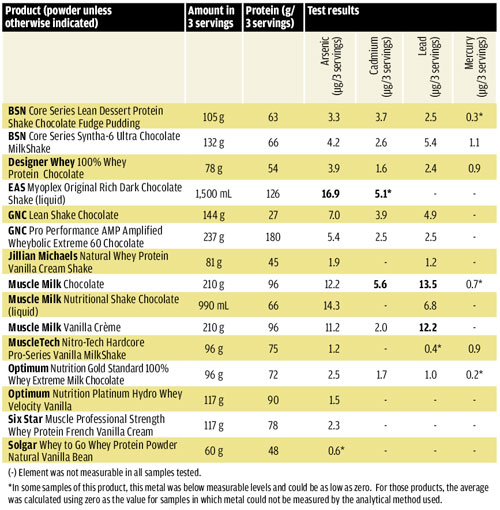
Kidneys
But processing excess intake can put pressure on the kidneys. Excess animal protein is linked with kidney stones. Highly processed food , heavy metals and let’s be honest AAS usage are all hard on the kidneys. No wonder so much bodybuilders suffer from kidney problems. At least be sure to drink plenty of water.
The heavy metal Cadmium found in some of these smples raises special concern because it accumulates in and can damage the kidneys, the same organs that can be damaged by excessive protein consumption. And it can take 20 years for the body to eliminate even half the cadmium absorbed today.
While adequate protein intake is indeed important during, getting this macronutrient via highly processed protein powders and high protein foods is a disastrous choice. This is because these same people that are drinking high protein smoothies and protein bars are very likely avoiding saturated fat at the same time. A diet high in protein and low in fat will, in the long run, be very unhealthy.
Whole foods containing large amounts of protein naturally include protective amounts of fat such as eggs, grass-fed beef and other meats. On the other hand, high protein processed foods are devoid of any fat in most cases making them particularly dangerous !! Our bodies are meant to have a balance array of proteins, carbohydrates, and fats in order to function optimally. Without the presence of some good quality fats, your body is not able to assimilate and absorb many vital nutrients. Imbalances in Calcium, Vitamin A, Vitamin K, and Vitamin D could result.
Vitamin A depletion when consuming high protein processed foods is also risky for the average individual as well. Symptoms of Vitamin A depletion include: heart arrhythmias, kidney problems, autoimmune disease and thyroid disorders etc.
Besides depletion of Vitamin A stores, high protein processed foods contain potentially large amounts of MSG in the form of protein isolates. Separating protein from its food source during manufacturing results in the creation of MSG – the amino acid glutamic acid gone bad. Therefore, MSG is present in high protein processed foods but it is not on the label because it is not technically added to the final product. It is only created during manufacturing and therefore can be conveniently unlisted on the label.
Don’t buy into the “low temperature dried” protein powder fallacy as well. While low temperature processing and drying of protein powders is a less damaging manufacturing method, it still denatures the protein. Whey protein in particular is very fragile and cannot be dried or powdered.
The idea was that muscles damaged during intense weight training could be repaired and developed by turning dried and concentrated whey, a by-product of cheese-making, into a drink. These shakes were seen as more efficient and convenient than having to eat large amounts of high-protein foods.
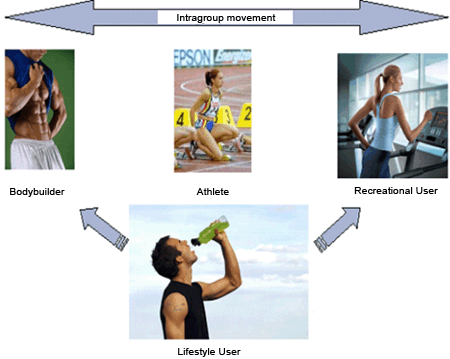
The rise of the protein drinks for “ordinary” people
Protein products are increasingly being marketed in supermarkets to ordinary people. Do they serve any real purpose for non-athletes?
The "sport-related" protein product sector is booming. It's estimated that the world will be chewing and gulping down £8bn a year of bars, drinks, and other supplements by 2017. And the most notable part of the growth is the shift to marketing to "ordinary" people. Among new shakes is Wing-Co, a chocolate-flavoured high-protein drink aimed as a snack alternative for men in their 30s and 40s who "aren't sucked in by lots of marketing rubbish".
But there's now a wave of products where the branding marks a departure from the traditional world of the protein supplements, the hardcore gym-goers and amateur athletes.
The typical customer was someone who wanted to build muscle and aid recovery after a serious workout.
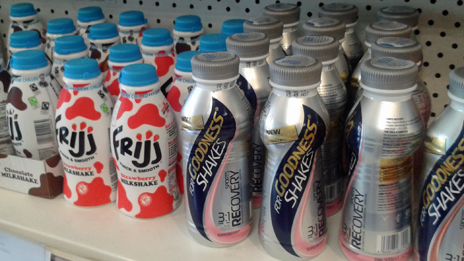 Leading supplier Maximuscle changed the market for protein drinks by advertising in lifestyle magazines and now the latest generation is positioned more around healthy lifestyle.
Leading supplier Maximuscle changed the market for protein drinks by advertising in lifestyle magazines and now the latest generation is positioned more around healthy lifestyle.
In the UK, a "high protein dairy drink" called Upbeat is the latest product to get a big marketing push. It follows the path blazed by For Goodness Shakes, a drink primarily aimed at gym-goers and athletes that was picked up by a wider pool of buyers.
Similar lifestyle protein products can be seen in the US on the shelves of the likes of Wal-Mart, K-Mart, Walgreens, and CVS.
New “ready-to-drink” protein drinks are often used as a Meal Replacement drink. The Telegraph revealed how model Adriana Lima drank only protein shakes for nine days before a major show And Business Week observed how dieters were shunning meat in favor of alternative forms of protein.
The new products aren't even marketed as "supplements". They might be a breakfast substitute for someone in a hurry, or pitched as an alternative to a snack.They benefit from the general aura of healthiness that hovers over the word "protein".
Blockbuster
A report by Denmark-based analysts 3A Business Consulting – entitled Global Opportunities for Whey and Lactose Ingredients 2010-14 – states that volume sales of whey proteins are rising strongly. Value sales are also ticking along nicely. This year, whey powder, proteins and protein factions will rack up sales of $5 billion rising to $6.4 billion in 2014 – annual growth of 4%.
Growth is being driven, according to 3A, by sales of high-end protein products such as WPC80, isolates and hydrolysates, which are finding favor in the nutrition sector, particularly sports and energy products.
Globally, the market for sports nutrition products (excluding sport beverages) is estimated at US$4.7 billion (Euromonitor, April 2010), of which, the United States (U.S.) is the largest consumer, representing approximately two-thirds of the world market in both volume and value of retail sales. Protein powders dominate the sports nutrition market with 42%.
Choosing a Protein Powder
Protein powders happen to be a very large product category with many choices. Many have difficulty sorting through all the options and choosing the right one. This article will help acquaint you with the different types of protein powder, what the key differences are among them and will help you zero in on the specific product that’s right for you.
The most common concerns people raise after looking at protein powders and reading labels are allergies to protein components such as lactose, soy, casein or eggs. Another common concern relates to artificial ingredients, which some wish to avoid. In both cases, there are plenty of alternatives from which to choose.
Despite the wide variety of protein powders available, the differences boil down to a few characteristics:
• The type(s) of protein used;
• The types of flavors and sweeteners used;
• Cost per serving or per gram of protein;
• Additional ingredients used to enhance the product’s benefits.
1. Type(s) of Protein
The types of protein used in protein powders can be divided into two categories: animal source proteins and vegetable source proteins. Animal source proteins include milk protein derivatives like whey and casein, goat's milk and egg white protein. Vegetable source proteins include soy, rice, pea and hemp proteins.
Nutritionally and taste-wise, animal proteins are superior to vegetable proteins and far more popular. Of the animal protein types, the most popular is whey protein. Of the vegetable protein types, soy is the most popular. Most people using vegetable protein powders do so as part of a vegetarian or vegan lifestyle, although many people use soy protein primarily for its heart-health and/or hormone-balancing benefits.
Whey Protein
Whey protein is derived from milk. The protein portion of whole milk consists of 20% whey protein and 80% casein protein. Whey is by far the most popular type of protein used in protein powders. For most people, it’s the best all-around choice in terms of taste (it’s one of the best-tasting), quality (it’s the highest) and cost (it’s the most economical). Another unique benefit of whey protein, and one that is often overlooked, is that it enhances the immune system in several ways.
Whey protein comes in two varieties, whey concentrate and whey isolate. The advantages of each are:
Whey Concentrate: Whey concentrate is more economical per gram of protein. It has a low lactose level that is well tolerated by most lactose-sensitive people. It has trivial amounts of fat and carbs relative to your overall nutrient intake. Whey concentrate is typically the best-selling category of whey.
Whey Isolate: Whey isolate is virtually fat-free for those wishing to eliminate as much fat from their diet as possible. It is typically lactose free for those few individuals who are very sensitive to the low-lactose levels found in whey concentrate. Whey isolate tends to taste slightly better than whey concentrate too, yet its consistency is a little thinner, without the fat.
Whey protein products can be made from whey concentrate, whey isolate or a blend of both. Other types of protein are sometimes combined with whey proteins in products and are known as protein blends.
Casein or Milk Protein
Like whey protein, casein protein is another milk protein derivative. Since most of the protein (80%) in milk is casein, the terms “milk protein” and “casein protein” are used interchangeably. The key difference between whey and casein is that whey is absorbed in the digestive system quickly, whereas casein is absorbed slowly and steadily. Taste-wise they are similar. Both are more or less tasteless in their unflavored and unsweetened state.
Customers often ask which is better, whey or casein. That’s a hard question to answer because both have unique benefits
Tip: Casein protein may not appear on labels as casein protein. It usually appears as calcium caseinate.
Egg White Protein
Egg white protein was the most popular type of protein supplement for many years before milk proteins surpassed its popularity due to their better taste and lower cost.
Like milk proteins, egg white is also naturally very low in fat and carbs.
Egg white protein is cholesterol-free and an excellent choice for those who wish to avoid dairy products.
Vegetable Proteins
Among the vegetable source proteins, soy protein is by far the most popular. Soy and hemp are unique among vegetable protein sources in that they supply all 8 essential amino acids. Most vegetable proteins lack one or more.
Soy has additional benefits, too. The isoflavones in soy provide antioxidant benefits, heart health benefits and is often used by women transitioning through menopause.
For all its benefits, soy protein has a characteristic taste that, while not unpleasant, can be hard to completely mask with flavors and sweeteners, especially when soy is the sole protein source in a product.
Some manufacturers found a way around this issue by using a proprietary blend of flavors and sweeteners.
Some products are unflavored and unsweetened. You can flavor it with frozen fruit, vanilla extract, cocoa powder, Emergen-C packets and sweeten it with xylitol, stevia, honey, agave nectar or whatever you like.
2. Types of Flavors and Sweeteners Used
Manufacturers have hundreds of options to choose from when flavoring and sweetening their protein powder products. Your flavoring choices fall into 3 categories:
1. No flavors or sweeteners;
2. Artificial or a combination of artificial and natural flavors and sweeteners;
3. Only natural flavors and sweeteners.
What you decide to use is up to you. The flavors and sweeteners have no impact whatsoever on the nutritional value of the protein; they only affect the taste.
All of the artificial flavors and sweeteners in protein powders have been approved for use in food products by all the relevant regulatory agencies. Artificial flavors and sweeteners have many advantages over their natural alternatives. They give the formulators more options, flexibility and control over the taste of the product. They cost far less. Smaller quantities are required. They have greater stability and suffer less degradation during storage.
Manufacturers purchase artificial flavors as finished, stand-alone ingredients from companies that specialize in such products. Since each company’s product name for their flavor ingredient would not be recognizable to the public, and since manufacturers need to protect their flavor recipes from being copied by competitors, these ingredients are simply listed on the label as artificial flavors. The same holds true for natural flavor ingredients.
While most customers use protein powders containing a combination of natural and artificial flavors and sweeteners, some still prefer an all-natural product. There are many excellent all-natural protein powders. These products contain only natural flavors and sweetening ingredients.
You may also want to use an unflavored and unsweetened protein powder for baking or for using your own flavors and sweeteners. Your two best choices are Lindberg 100% Whey Concentrate Unflavored or Fitness Labs Soy Protein Isolate. The whey protein is the more neutral tasting of the two.
3. Cost
There aren’t huge differences in protein powders when comparing similar products with similar ingredients. It is easy to compare prices on protein powders that just contain one type of protein. The difficulty arises when comparing products that are blends of protein types. Some proteins are more expensive than others and without knowing the proportions of each type in the mixture, a comparison is hard to make. Some companies add other nutrients like amino acids or digestive enzymes to their protein, making price comparisons even murkier.
In protein blends, manufacturers usually describe their unique mixture of protein types as a proprietary blend. The ingredient list will show the types of protein proportionately, from most to least, but won’t provide the exact amount of each type.
If you are trying a protein for the first time, buy the smallest size possible. Once you’ve found a product you like, the largest size offers the best value and gives you substantial savings over smaller sizes. A 2-pound tub of protein may seem like an awful lot, but will typically contain only 23-30 servings. If you use the product every day, that’s just under one month. Save yourself time and money by buying the largest size possible once you’ve found a product you like.
4. Enhancements
Besides protein, flavors and sweeteners, many manufacturers add other ingredients to enhance the product’s nutritional value or taste, or to make it easier to use.
One very common enhancement, and one that most customers prefer, is the addition of small amounts of lecithin to protein powder. Lecithin is a healthy fat from soy. It’s added to improve the mix-ability of the powder and reduce clumping. Unlike other soy foods, lecithin does not have any phytoestrogen compounds and makes a great addition to a protein shake. Many customers actually add lecithin granules to shakes for memory enhancing and cardiovascular benefits.
Other protein powders are enhanced with digestive enzymes to help improve the absorption of large servings of protein. Added lactase and Aminogen digestive enzymes in Optimum Nutrition 100% Whey Gold Standard is one example.
Another way to enhance a protein powder is by adding amino acids to improve its nutritional value. Although whey protein contains all the necessary amino acids, it doesn’t provide them in equal amounts. By adding amino acids like glutamine, BCAAs and arginine, the nutritional benefits of that protein are extended and enhanced.
Other types of enhancements include the addition of carbohydrates and nutritional fats to the protein and/or the addition of vitamins and minerals. However, when these types of ingredients are added, the products can no longer be accurately called protein powders. Such products are known as Meal Replacements or Gainers with Carbs.
- Login to post comments


